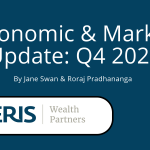What An Impact Investor Knows
By Luisamaria Ruiz Carlile, Wealth Manager
As impact investing gains momentum, a common question we hear is: “What does the new breed of impact investors know that traditional investors don’t?” What insights have transformed these impact investors’ approach?
Here are three insights to consider:
- Collectively, we have always been impact investors. Whether we know it or not, we have been shaping and transforming economies and ecosystems through our capital allocations for centuries. What we choose to finance – and what we don’t – has significant consequences for everyone. For instance, for decades we have been subsidizing oil and coal companies with hundreds of billions of dollars, while drastically underfunding renewable energy and conservation. As a result, we’re now scrambling to reverse environmental damage, create new sustainable industries, and assure that we have a dependable energy supply for our collective future.
- We can own the impact created by our portfolios. Impact investors are saying “yes” to actively directing their investment dollars toward social and environmental goals, and “no” to the negative impact their portfolios have on society. In applying their financial muscle to innovative opportunities and challenges, impact investors are finding solutions. Whatever their goals – poverty alleviation, sustainable agriculture, environmental solutions, economic diversity and inclusion, among many others – impact investors know they can incorporate sustainability and impact across the many asset classes that make up their portfolios.
- Investing for impact does not mean sacrificing investment performance. For years, investors have been told that impact and sustainable investments underperform their peers, that investing for social benefits means lower financial returns. The data solidly refutes this assertion. For example, the MSCI KLD 400 Social Index, launched in May 1990, tracks companies with high ESG* ratings. The MSCI KLD 400 had a 9.95% annualized return over 20 years, slightly outperforming the S&P 500 Index, which had a 20 year annualized return of 9.78%. A second excellent data point is the Dow Jones Sustainability World Index, which tracks global companies in the top ten percent for ESG criteria.
***
As impact investing goes mainstream, it is upending the long-standing assumptions about “Passive” vs. “Active” investing. For some time now, the accepted wisdom of “Passive” investing has been to pick an asset allocation and populate it with low-cost, traditional index funds. Hand over the investing keys. Await returns.
“Active” impact investors, on the other hand, are not settling. Energized by embedding their values and passions into personalized portfolios, they expect multiple returns on their invested capital. Earning competitive financial returns is just the starting baseline. From there, it’s the additional benefits of investing for impact that are crucial: a healthy planet, thriving communities, diverse and inclusive workplaces.
Impact investors embrace a broad universe, including supporting micro-finance, shareholder-advocacy and community development. Impact investors are financing leading sustainable businesses and forward-thinking enterprises.
Compared to the personal, social, environmental and financial returns that “Active” impact investors are creating with their portfolios it now appears that “Passive” traditional investing is giving up much more. What a transformative moment in the history of investing.
*ESG (Environmental, Social and Governance) criteria used to rate the sustainability of companies







